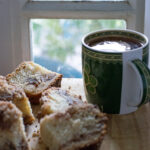I have a delicious hobby . . . I collect antique teacups and teapots. There is something so timelessly elegant about a dainty, bone china tea set. Each piece has a story, and each story is unique.
Nothing soothes the stress of a day away like a nice, piping hot cup of tea– preferably sipped with a friend over a good conversation. Ahh– it’s bliss.
Every good afternoon tea needs a little bite of something, to go with it (everyone knows that, if you give a mouse a cup of tea, he’s going to want a snack to go with it . . .). So it’s time to go back to that old teatime standby– the beautiful scone. I have sung the praises of these little beauties, before– pumpkin scones, here, and cranberry almond scones here. I am constantly recreating scones to fit current tastes and what type of fruit or produce I have on hand. They lend themselves so well to both sweet and savory tastes, and the mini scones are so darned cute . . . you just can’t go wrong.
So what are we waiting for? Let’s do this!
Lemon Blueberry Scones
(adapted from Allrecipes.com and reinvented for my own taste)
Ingredients:
2 cups all purpose flour
1/3 cup sugar
1 tsp. baking powder
1/4 tsp. baking soda
1/2 tsp. salt
1/2 cup (1 stick) butter or margarine, chilled
1 cup dried blueberries
The juice and zest from 1 lemon
1/2 cup sour cream
1 egg
Lemon Glaze:
2 cups powdered sugar
The juice from one lemon
1 tsp. water, if necessary
Directions:
Mix dry ingredients together. Cut in butter with a pastry cutter. Stir in lemon juice, lemon zest, and dried blueberries. Add in the beaten egg and sour cream until the mixture is moistened into a heavy dough. Roll the dough into a flat circle about 1.5″ thick. Cut into 8 wedges and place on a silpat-lined baking sheet. If you prefer mini scones, make 2 smaller rounds before you cut out your scones. Bake at 400 degrees for 15-18 minutes, until a toothpick inserted into the center of a scone comes out clean. When scones have cooled, dip in lemon glaze and allow to dry on a cooling rack.
Now, in pictures! 🙂
Start out by mixing your dry ingredients together. Bring out your old faithful whisk and whisk those babies together.
You know, I really love my whisk. It is old and beaten up, but then again . . . you should have seen the other guy. 😉 It has beaten lots of bad guys into pulp, for me, over the years.
Take your pastry cutter and cut in your butter. I adore the Perfect Pie Blender, here , because it has a flat bottom (unlike the traditional curved pastry cutters), which makes it much easier to get the job done nice and fast.
, because it has a flat bottom (unlike the traditional curved pastry cutters), which makes it much easier to get the job done nice and fast.
Mind if I . . . cut in?
Now, it’s time to make our life a little . . . zesty. Have you ever zested a lemon, before? It’s really pretty easy– you can use a zester, which is kind of like a teeny microplane grater, or you can use a small grater. Scrape the lemon quickly across the grater, so that you get all the yellow part of the skin. You don’t want any of the white part– that is called the “pith,” and it’s bitter and nasty. Yes . . . it’s bitter and nasty like that person who stole your parking space at Walmart today. Leave it out.
Go ahead and add this zest and the juice out of that same lemon to your scone mixture. Sweet little lemon, giving us both its coat and its juice . . . the giving lemon.
Now, let’s talk blueberries. You can certainly use fresh blueberries, if you like. I am choosing to use dried blueberries because (1) I didn’t have any fresh blueberries), and (2) dried blueberries are sweeter and are less likely to stain the scones purple. If you are using dried fruit, I suggest soaking the berries for about 5 minutes in hot, almost boiling water. This soaking helps the berries to plump up, a little bit, and keeps them from being moisture-sucking bombs in your finished scones. When you are ready to use the blueberries, drain them in a colander. You want them plump, but not dripping wet.
Now, we have our lemon zest, lemon juice, and drained blueberries mixed into the flour.
Now, get ready to flex your muscles, because this part is a little tough. Add in your sour cream and beaten egg– and start to M . .I . .X . .
I admit it– mixing this dough is hard. It’s kind of like trying to stir play dough with a spoon. But if the British had been faint of heart, we’d all be speaking German, now, wouldn’t we? So keep calm and . . . stir . . . on.
It won’t seem like you have enough liquid. You will think, “This is NEVER going to come together.” You will want to add a gallon of milk to make it easier.
Don’t.
Just like the future, it will come together. Somehow, even if we don’t see how, it will. We just have to work at it. There’s a life lesson in there, somewhere.
After an insane amount of stirring, when you have biceps the size of watermelons, your dough will be ready. If you have stirred for at least 5 minutes, and your dough is still not coming together, you MAY add a few more tbsp. of sour cream– it may be that your lemon was not as juicy as mine was, or your egg was on the small side. But try not to add any more than that.
You want this dough to be thick enough that the spoon will stand upright in it, with no support.
Phew. Let out a breath– the hard part is over, now. It’s all smooth sailing from here on out.
Decide if you want regular size (roughly 3-3.5 inch long) scones or mini (1.5-2 inch) scones. If you want regular scones, place your dough on a floured surface and roll your dough into a single, 2 inch tall circle. If you want mini scones, form your dough into 2 separate circles. Use a pizza cutter to cut your flattened circle into 8 equal pieces.
Place your dough wedges on a silpat lined baking sheet. Silpats are an amazing invention– and I use them every single day in my kitchen. They are kind of like reusable parchment paper– and absolutely nothing sticks to them. Pop those babies underneat cookies, scones, or even a pie or casserole, and voila . . . the spills that drip over the side wipe right off with a wet paper towel. Get a silpat here if you’re interested.
Bake the scones at 400 degrees for roughly 15 minutes, or until golden brown. A toothpick inserted into the center of the scones will also come out clean, when they are finished baking.
While your scones are baking, go ahead and make your glaze. Grab your trusty whisk again. I’ll show you how I made my glaze, but keep in mind that all lemons are a little different, so you may need to adjust your glaze to fit your own tastes. I found that 2 cups of powdered sugar, combined with the juice of one lemon, and then just a splash of water to thin the glaze a little bit, was just right for me. Taste it and see what you think. If you think it’s too sweet, add a little more lemon juice. If it’s too sour, add a touch more powdered sugar.
Whisk that beautiful stuff into a gorgeous glaze. It should be thin enough to ribbon off your whisk, but not as thin as water.
When your scones are finished baking and have cooled, a little bit, dip your scones in the glaze and let them dry on a cooling rack over a silpat lined baking sheet. I told you the silpat would make cleanup a snap. You can just wash the grime off in one easy step, when you’re done.
When all your scones have finished, let them dry for about an hour, until the glaze is dry and the scones are stackable without being sticky.

Grab a good book, a nice cup of tea, and one of these cheery little scones. Something about lemon can cheer up even the grayest of days.
So sip your tea, read your book, and take a bite. Savor each one. Breathe deeply and let all the stress ooze out of your day. Life is beautiful. Have another bite and smile.
Because you did it. And I’m just so proud of you.

Disclosure: This post may contain affiliate links, which just means that we get a few pennies if you purchase through our link. I never recommend products that I don't personally use and love. Thanks!




















